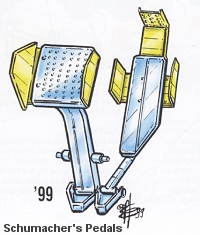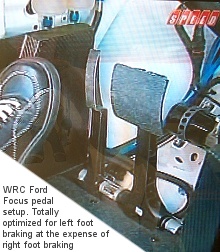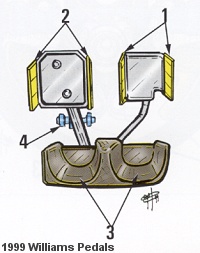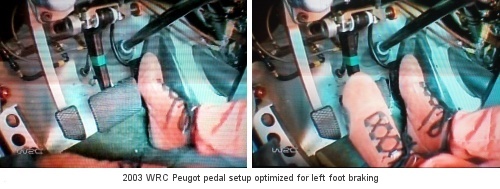|
| |||||||||
| |||||||||
|
|
|
|
| |||||||||
| |||||||||
|
|
 "The (1997 Sauber) C17 is a conventional car with the now normal paddle gearchange, and traditional
(foot pedal) clutch control...
"The (1997 Sauber) C17 is a conventional car with the now normal paddle gearchange, and traditional
(foot pedal) clutch control...'I have been asking for two pedal control (with a paddle clutch) for a year and a half,' adds Herbert. 'I want to try it, just to see what it is like. You can't really left foot brake with the pedals as they are now, they are too close. If you listen to the cars going into Becketts, it sounds as if Michael Schumacher is taking it flat. In fact, he is left foot braking against full power. We have to lift there." Interview with Johnny Herbert (Sauber Driver) Race Tech Magazine #19 The quote above is meant to point out that, in top level motorsports today, the capability of a driver to left foot brake is increasingly a necessary skill if he is to succeed. Certainly this has been the case for some years now in F1 and World Rally. And as more racecars become equipped with semi-automatic gearboxes (the all conquering Audis at Le Mans for example) drivers are finding that full time left foot braking can give them an edge over competitors constrained (by ability or equipment) to traditional right foot braking. | |||||||
 Even in race series mandating standard sequential manual gearboxes, left foot braking is more
prevalent than one might think. This is due to the fact that the "dog boxes" in such cars allow up and down
shifting without the use of the clutch (up shifts aided by an electronic cutout). During the latter half of
the 1990's drivers in the very popular BTCC series could be seen left foot braking from the in-car footage
as they banged down through the gears. Even Winston Cup drivers can be seen left foot braking on road courses
such as Infineon Raceway.
Even in race series mandating standard sequential manual gearboxes, left foot braking is more
prevalent than one might think. This is due to the fact that the "dog boxes" in such cars allow up and down
shifting without the use of the clutch (up shifts aided by an electronic cutout). During the latter half of
the 1990's drivers in the very popular BTCC series could be seen left foot braking from the in-car footage
as they banged down through the gears. Even Winston Cup drivers can be seen left foot braking on road courses
such as Infineon Raceway.
| |||||||
 Braking with the left foot offers two distinct advantages. First, it completely eliminates the awkward
transition period experienced when switching from braking, back to on-throttle.
This transition occurs at the end of a braking zone when a driver has
to momentarily lift the right foot from the brake pedal in order to move it over to the throttle pedal
- a "dead-zone" so to speak.
A skilled driver is able to reduce the unsettling effect that this transition has on the car, but it is still
always there to some degree.
Braking with the left foot offers two distinct advantages. First, it completely eliminates the awkward
transition period experienced when switching from braking, back to on-throttle.
This transition occurs at the end of a braking zone when a driver has
to momentarily lift the right foot from the brake pedal in order to move it over to the throttle pedal
- a "dead-zone" so to speak.
A skilled driver is able to reduce the unsettling effect that this transition has on the car, but it is still
always there to some degree.
Second, when braking with one's left foot it is actually possible to brake while still on the throttle - to play the two effects against each other for short periods of time. This technique is most clearly illustrated by the reference to Michael Schumacher above. On many tracks there are certain corners where generally all that is needed is a momentary "lift" off the throttle in order to make it through. But anyone with a little track driving experience is aware that lifting during a corner tends to produce an unsettling effect on a car which is already near the edge of adhesion. | |||||||
 However, an alternative technique is to remain at the existing throttle setting at this phase, and simply apply a
small feathering of the brake pedal to ease the car around the bend. This has quite the opposite
effect of lifting and actually causes the car to "hunker down" a bit. It settles the car through this critical
portion of the turn. An auto-x slalom is also a place where left foot braking against engine
power can be used to advantage. Most
proficient auto-crossers will be adept at left foot braking, and will use it most any time
that they do not have to heel-toe downshift for a corner.
However, an alternative technique is to remain at the existing throttle setting at this phase, and simply apply a
small feathering of the brake pedal to ease the car around the bend. This has quite the opposite
effect of lifting and actually causes the car to "hunker down" a bit. It settles the car through this critical
portion of the turn. An auto-x slalom is also a place where left foot braking against engine
power can be used to advantage. Most
proficient auto-crossers will be adept at left foot braking, and will use it most any time
that they do not have to heel-toe downshift for a corner.
| |||||||

| |||||||
|
But left foot braking is not only advantageous on the track. Once the driver is completely comfortable with the technique it can be used to good effect on the street. It can lead to smoother transitions at stop signs and when going over speedbumps and driveway entrances. Not to mentioning having some fun trail braking into a corner to show that SUV behind you who is really "Master of the Road" ;-) Ultimately left foot braking is a tool which can give a driver greater control over his/her car, and this is a good thing in any driving situation. Warning - if you are not yet accustomed to left foot braking then it should only be practiced in a safe, closed environment, not on public roads or on a race track. The left foot is generally trained to modulate a clutch pedal. Learning to modulate a brake pedal with the left foot will take some time. Be safe. One excellent place to practice left foot braking is at a karting track. All karts use a two-pedal setup and require that the left foot be used for braking. Transferring these skills to your M3 is nothing more than a change of mindset. Folks often like to say of their cars: "It handles like a go-kart!", and we know this to be true of the E46 M3, once you get it set up. Well, with the P7 pedal you can drive an M3 like a kart too 8^) Next page ... | |||||||
|
| |||||||
|
|
|